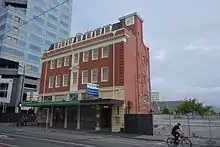Heathcote Helmore
Heathcote Helmore (1 May 1894 – 21 May 1965) was a notable New Zealand architect. He was born in Rangiora, North Canterbury, New Zealand in 1894 the eldest child of Christchurch-born solicitor George Henry Noble Helmore[note 1] and his wife Janet Maud Gray. Like his father he attended Christ's College. At 17 he was articled to architect Cecil Wood but before his time was complete war broke out and he served four years as wartime A-d-c to New Zealand's Governor later Governor-General Lord Liverpool. He was admitted to the New Zealand Institute of Architects in June 1920.[1]
Heathcote Helmore | |
|---|---|
| Born | 1 May 1894 Rangiora, New Zealand |
| Died | 21 May 1965 (aged 71) Christchurch, New Zealand |
| Nationality | New Zealander |
| Occupation | Architect |
| Practice | Helmore and Cotterill |
| Buildings | Vogel House Fernside Homestead |

In mid 1920 he went with Guy Cotterill to London to expand their architectural knowledge and experience by working in the offices of well-known firms including in his case some time as an assistant to Edwin Lutyens. He returned to Christchurch and set up his personal practice in February 1923 winning some substantial commissions.[1]
Helmore and Cotterill
In 1924 he went into partnership with Guy Cotterill. The partnership between Helmore and Cotterill lasted until Helmore's death in 1965.[1] Helmore designed Victoria Mansions in 1931; the apartment building's construction did not start until 1935, though.[2] He designed the Canterbury Pioneer Women's Memorial that is placed at the top of the Bridle Path that goes from Lyttelton to the Heathcote Valley.[3]
Notes
- Captain of Canterbury Rugby and New Zealand Rugby Representative to Australia 1884
References
- Esau, Jonathan Robert (1 January 1988). "Helmore and Cotterill : the formative years". Cite journal requires
|journal=(help) - "Victoria Mansions". Register of Historic Places. Heritage New Zealand. Retrieved 24 January 2020.
- "A drawing by Mr Heathcote Helmore". The Press. LXXV (22667). 23 March 1939. p. 2. Retrieved 11 March 2017.